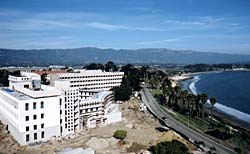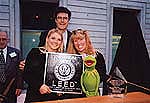by Dennis J. Aigner
When students start classes next fall at the Bren School of Management at the University of California, Santa Barbara (UCSB), their education wont start at the classroom door. The Schools new home, Donald Bren Hall, is a $26 million structure that incorporates green building practices and materials into virtually all of its 85,000 square feet.
Formally opened on April l9, 2002, this landmark building is situated on a half-circle land parcel just above Goleta Bay, offering a breathtaking view of the Pacific Ocean. Named in honor of Donald Bren, owner and chairman of the Irvine Company, for his generous programmatic support, the building is curbed against the east-facing shores and surf, harvesting natural sunlight and ocean breezes through the large windows and open courtyard. And, thanks to over 300 sunny days a year in California, a 47-kilowatt photovoltaic system will generate 7 to l0 percent of the buildings electricity cleanly on-site.
All aspects of the buildings construction – site preparation, materials and utilities-represent the latest in sustainable technologies. Even the lavatories, with glass counter tops and partitions made from recycled glass, concrete and plastic bottles represent examples of green construction.
Not only is this living laboratory one of the greenest buildings in California, its only the second building in the nation to achieve a Platinum rating for Leadership in Energy and Environmental Design (LEED) by the U.S. Green Building Council. This level of distinction is the highest honor given to any capital project. The building surpasses California energy code, Title 24, by 32- 40 percent.
Kermit the Frog even showed up to serve as official spokesfrog for the grand opening. Kermit has often sung Its not easy being green, but at the grand opening of one of the nations greenest buildings, he came to tell the world that being green is easier than you think.
The creation of Donald Bren Hall began in 1992 with the vision of building a living laboratory that incorporated the highest level of performance and sustainability.
The architecture firm for this project was Los-Angeles based Zimmer Gunsul Frasca Partnership. The general contractor is San Diego-based Soltek Pacific Company. Contract specifications required the builder to separate and reuse waste and to minimize debris taken from the site. 100 percent of the demolition waste and 92 percent of the construction waste was recycled.
What is LEED? |
| A priority program of the U.S. Green Building Council, LEED is a self-assessing rating system for new and existing commercial, institutional and high-rise residential buildings. It evaluates environmental performance from a whole building perspective over a buildings lifecycle and provides a definitive standard for what constitutes a green building. In the U.S., buildings use 1/3 of our total energy, 2/3rds of our electricity, 1/8th of our water and transform land that provides valuable ecological services. LEED was created to: Points are earned in five categories: There are four levels of certification: LEED Certified, Silver Level, Gold Level and highest, Platinum Level. |
Reuse and Recycle
The cost to go green was less than two percent of the total building cost. Though the original site was a parking lot, great efforts were made to scale the footprint of the construction site to preserve the existing landscape and habitats. Trees were protected and smaller plants were ground and used as mulch. Asphalt and concrete curbing and all the native soil were ground up and re-used. Drought-tolerant native plants and other landscaping methods were used to shade the building.
The structural steel of the building has 80 percent recycled content thanks to Californias leading metal commodity automobiles. The office wing is constructed using galvanized steel made from 30 percent recycled content, concrete with a 17-20 percent mix of fly ash (resistant to sulfur and saltwater) and rebar that is 80-90 percent recycled. There are two types of insulation fiberglass and mineral wool. The fiberglass has a recycled content of 30 percent (reycled glass and sand) while mineral rock has a recycled content of 60 percent. The drywall is made from cornstarch, 100 percent recycled paper and recaptured and natural gypsum.
The primary flooring material is biodegradable linoleum, made from linseed oil, limestone and wood flour. Cork is used in the student commons area. Cork is especially effective for acoustical and thermal insulation, and is durable and very resistant to mildew. Rubber flooring made from 100 percent recycled tires is used on the third floor. Other floor areas are covered with EarthSquare carpet, which was donated, installed and cleaned on-site by Milliken & Co. textiles. 14 tons of used carpet was recycled and kept out of the landfill as a result.
Reducing the Load
Another feature of the new building is its connection to a new multi-building chilled water loop that conserves the run time on the chiller to approximately 14 percent and provides cost-effective cooling for the laboratory wing. An 85 percent efficient, low emissions Parker Boiler is used in the building.
To ensure efficient use of energy, Bren Hall was built to take advantage of natural heating, cooling and light. The office wing, which faces the ocean, has no air conditioning, relying instead on flow-through ventilation with operable windows and transoms. Indoor air quality goes far beyond the predictable smoking ban, as the building contains a permanent air monitoring system, ensuring air changes at least six times per hour in the lab wings and eight times an hour on the second floor. Windows in the office wing have a mechanical
interlock (a small sensor in the frame) so that when opened, the heaters automatically shut off.
The lighting system uses energy-efficient lamps and ballasts as well as sensors for motion, heat and ambient light.
In the bathrooms, first-floor toilets use reclaimed ground water; and the urinals are waterless, using an oil barrier to trap odors and wastewater. The result is saving an estimated 45,000 gallons of water per urinal each year. All toilets have automatic flush valves and low flow fixtures are used throughout the building.
Other features include the use of paints and adhesives that exceed the new 2005 air quality and lead free standards; a perimeter fire road made of permeable turf-block with a grass overlay; a white cap Energy Star roofing system that reflects heat and reduces cooling needs; and showers and enclosed bicycle lockers to encourage alternative means of transportation. A solar PV system from PowerLight Corporation is on the rooftop. The 47-kw system qualified for a $183,000 rebate from the California Public Utilities Commission under its buy-down program.
++++
| Dennis J. Aigner is dean of Bren School of Environmental Science & Management at University of California, Santa Barbara. |
The Bren School is headquarters to a University of California system-wide graduate program linking students and faculty throughout the 10- campus system in the areas of science, management, law and policy. The program is unique in the UC system. The Bren School plays a leading role in researching environmental issues, training research scientists and environmental management professionals, and identifying and solving environmental problems around the world.
In addition to Milliken & Co., the strategic partners for this project are Armstrong, Johnson Controls, Pacific Earth Resources, Parker Boiler, Sarnafil-U.S. Division, Southern California Edison, To Market, Valley Crest Tree Co., PowerLight and Waterless Co.
Learn more about LEED: www.leed.org

